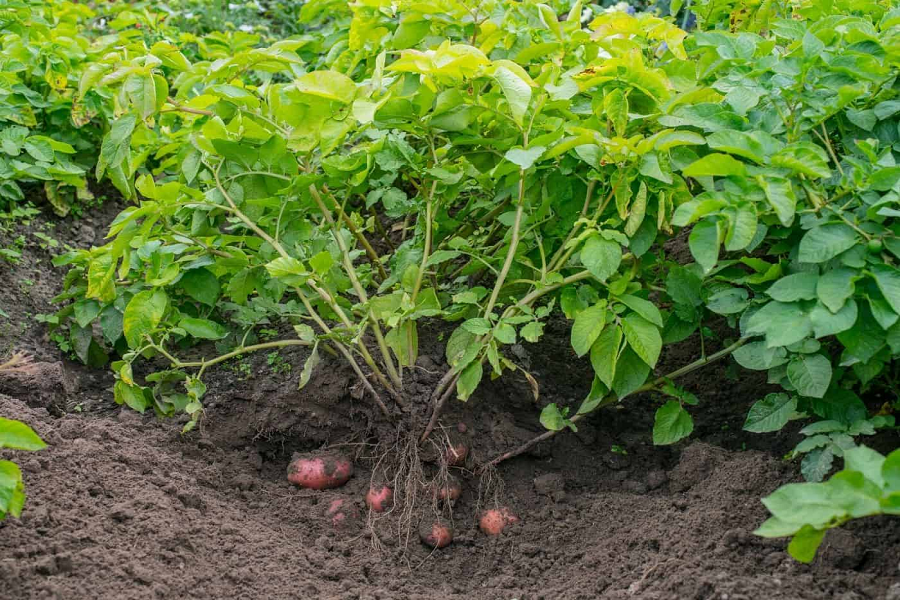How To Grow And Harvest Red Potatoes In Your Garden?

Image Source: www.homefortheharvest.com
Growing your red potatoes in your garden can be a rewarding and delicious experience. Red potatoes are not only a versatile and tasty addition to your meals, but they are also relatively easy to cultivate. In this article, we will guide you through the process of growing and harvesting red potatoes in your garden, breaking it down into seven essential points.
1. Choosing The Right Location
The initial phase of cultivating red potatoes effectively involves choosing an appropriate spot for your potato bed. Fertile, loose, well-drained soil is ideal for growing red potatoes. Pick a location for your garden that gets six to eight hours of direct sunlight per day. Make sure there is adequate drainage in the soil to avoid waterlogging, which can cause rotting.
2. Preparing The Soil
An important step before planting red potatoes is to adequately prepare the soil. Using a garden fork or tiller, begin by loosening the soil to a depth of around 8 to 10 inches. Clear the area of any rocks, plants, or garbage. For nutrient-rich soil, incorporate well-rotted manure or organic compost. Red potatoes like their soil to have a pH of between 5.8 and 6.5, which is somewhat acidic.
3. Choosing Red Potato Varieties
Red potatoes come in a variety of kinds, each having a distinct flavor and set of qualities. Red Pontiac, Red Bliss, and Norland are a few of the well-known red potato cultivars. Select a type that fits your environment and taste. At your neighborhood garden center or nursery, you can buy certified seed potatoes.
4. Planting Red Potatoes
Planting red potatoes is relatively straightforward. Begin by cutting your seed potatoes into pieces, making sure each piece contains at least one or two “eyes” or buds. Allow the cut pieces to air dry for a day or two to minimize the risk of rot. Plant the seed potatoes in rows, spacing them 12 to 15 inches apart, with a depth of about 3 inches. Rows should be spaced 2-3 feet apart to provide enough room for the potato plants to grow.
5. Caring For Your Potato Plants
Caring for your red potato plants is crucial to ensure a bountiful harvest. Here are some key care tips:
– Watering:
Keep the soil consistently moist but not waterlogged. Deep, regular watering is essential, especially during dry spells.
– Fertilizing:
To encourage root development, apply a fertilizer that is balanced and contains a higher amount of phosphorus. For accurate application, refer to the fertilizer package instructions.
– Hilling:
Mound soil around the base of your growing potato plants to promote tuber growth and shield the young potatoes from the sun, which can cause them to turn green and become toxic.
– Mulching:
Mulch should be applied to the soil to assist in retaining moisture and prevent the growth of weeds.
6. Harvesting Red Potatoes
If you want your red potatoes to have the best flavor and texture, you need to know when to harvest them. When the red potato plants’ tops begin to wither and turn a shade of brown or yellow, it’s usually time to harvest. Carefully, with a garden fork or your hands, dig around the plant’s base to pick the tubers, making sure not to damage them. To prepare them for usage, gently brush off any extra dirt, but wait to wash them.
7. Storing Your Harvest
After harvesting your red potatoes, it’s essential to store them properly to prolong their freshness and flavor. Here are some storage tips:
– Cure The Potatoes:
Leave freshly harvested potatoes in a cool, dark, and well-ventilated area for about two weeks. This allows the skins to toughen, which improves their storage life.
– Store In A Cool, Dark Place:
Once cured, store your red potatoes in a cool, dark place with good air circulation. Ideal storage temperatures are around 45-50°F (7-10°C). Avoid storing them in the refrigerator, as the cold can change the potato’s flavor and texture.
– Check For Sprouting:
Periodically check your stored potatoes for any signs of sprouting or rot and remove any affected ones to prevent spoilage of the entire batch.
Conclusion
Red potato cultivation and harvesting in your garden can be a rewarding and enjoyable task. You may reap a plentiful harvest of these tasty and nourishing tubers with the proper site, soil preparation, care, and attention to detail. To successfully grow red potatoes and enjoy the benefits of homegrown goodness on your dinner table, follow the guidelines provided in this article.






